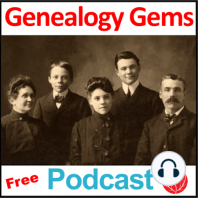47 min listen

Episode 169 - Blast from the Past Episode 14
FromThe Genealogy Gems Podcast with Lisa Louise Cooke - Your Family History Show
Episode 169 - Blast from the Past Episode 14
FromThe Genealogy Gems Podcast with Lisa Louise Cooke - Your Family History Show
ratings:
Length:
53 minutes
Released:
Jul 14, 2014
Format:
Podcast episode
Description
Catch a glimpse of the silent movie era and how it was an integral part of your ancestors’ lives. In this episode, I find out more about the silent movies my grandmother catalogued in her diary, and how they molded a generation. The cultural influences of the “Picture Shows” Below is a page from my grandmother’s journal documenting the silent films she saw that year, including the actors who starred in them. Just like today, the stars who light up the silver screen were mimicked and followed for fashion trends, hair styles, decorating ideas, and moral behavior. Understanding who the role models were at the time gives us a better understanding of the cultural influences of the era. Films are NOT primary resources, but they certainly paint a picture of life at any given time in history. Finding silent films in my area To learn more about silent films, I started with a simple Google search, altering my search criteria until I found movie theaters that showed silent films in my area. The first theater I found was the Stanford Theatre, located in Palo Alto, California. It was first opened in 1925 and stood as Palo Alto’s premier theater house for several decades. In 1987, the David and Lucile Packard Foundation bought the theater and restored it. It is now owned and operated by the non-profit Stanford Theatre Foundation. www.stanfordtheatre.org - The website provides all the movie schedules from 1929-1961, compiled from ads that appeared in the Palo Alto Times. Vaudeville acts were also regularly included in the lineup. And the Wurlitzer organ live accompaniment was a staple. Grandma’s Diary Entry – Sunday, April 22, 1928 I have to lead singing at church. Walter and I went to the lake. Met Helen Weathers and Jesse Jay and Ed Taylor. Helen and I went in swimming. Went to the show afterwards. The vaudeville was keen. Lew Cody in “Adam and Eve.” The first silent movie I saw was “Diary of a Lost Girl”, a German movie starting Louise Brooks. It was a late entry silent film released on April 24, 1930. It tells the story of an innocent young girl, who is raped by the clerk of her father’s pharmacy. After she becomes pregnant, she is rejected by her family and must fend for herself in a cruel world. It was not the wholesome far I expected but was riveting nonetheless. (I must acknowledge the organ accompaniment of Dennis James because he added a drama and magic to the film that was priceless.) The next film I saw was the classic 1923 comedy “Safety Last” starring Harold Lloyd. This is a must-see, full of laugh-out-loud humor. I was starting to get a feel for what drew Grandma to the pictures as a young girl. It was magical, glamorous, and hugely expanded her social network. Society’s views on the silent film era To learn more, I was combed through newspapers from her home town in the 1920s at the State Archives. I came across two newspaper articles: “Getting Back to the Home” from January of 1925, and “Harking Back to those Old Home Days” from February 5, 1925. The first article leads in… “Much has been said as to the methods of checking the crime and rebelliousness among the young people of today. The automobile, trains and other means of travel as well as moving pictures, dance halls, etc. that attract young people, and so lead them to seek amusement away from home have contributed to the fact that the home is not the center of attraction for the majority of families as it once was.” The article went on to say that there were plans in the works for a community get-together. The February 5th article reported the events of that evening, which was called “Back to the Home.” The local residents ate pumpkin pie, sang songs, listened to speeches and music, and comic readings. (And I happened to recognize the name of the cellist in the orchestra as being the man who signed as witness on my great-grandfather’s naturalization papers!) The even was a huge success and was deemed “something that will in surely bear repeating.” Immediatel
Released:
Jul 14, 2014
Format:
Podcast episode
Titles in the series (100)
Episode 43 - Genealogy at Borders, & New U.S. Census History Site: Genealogy at Borders, RootsTelevision & New U.S. Census History Site by The Genealogy Gems Podcast with Lisa Louise Cooke - Your Family History Show